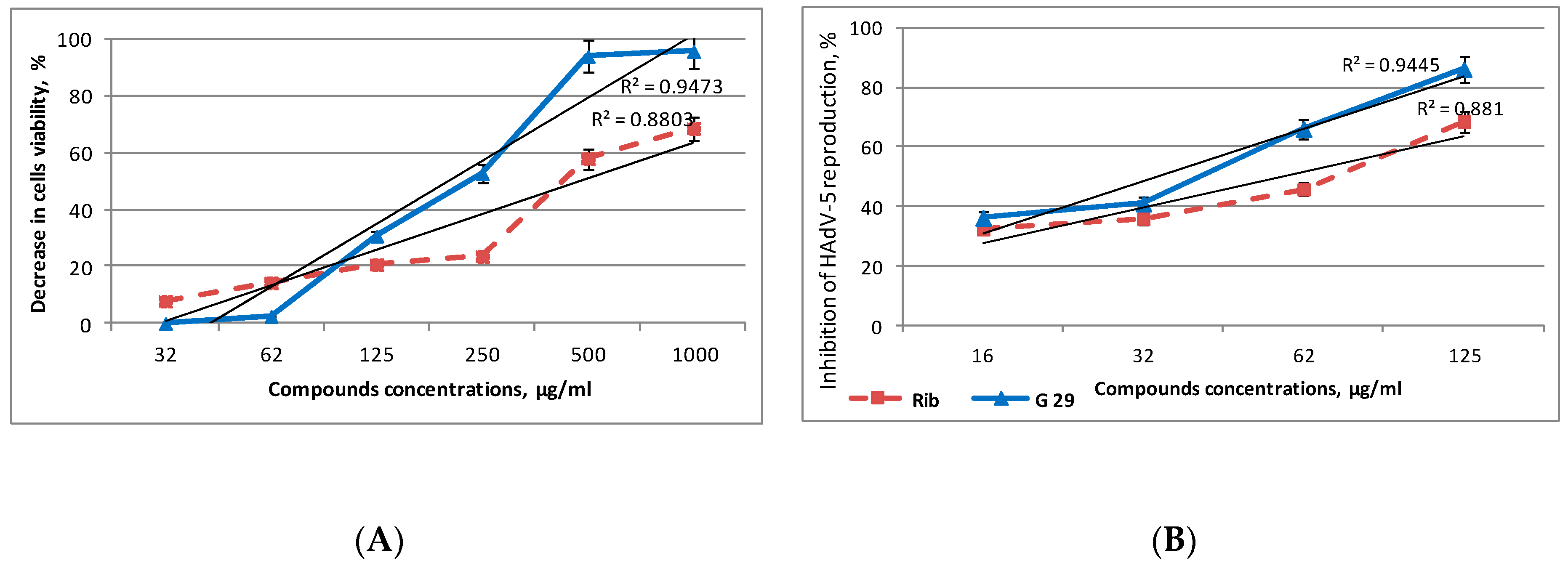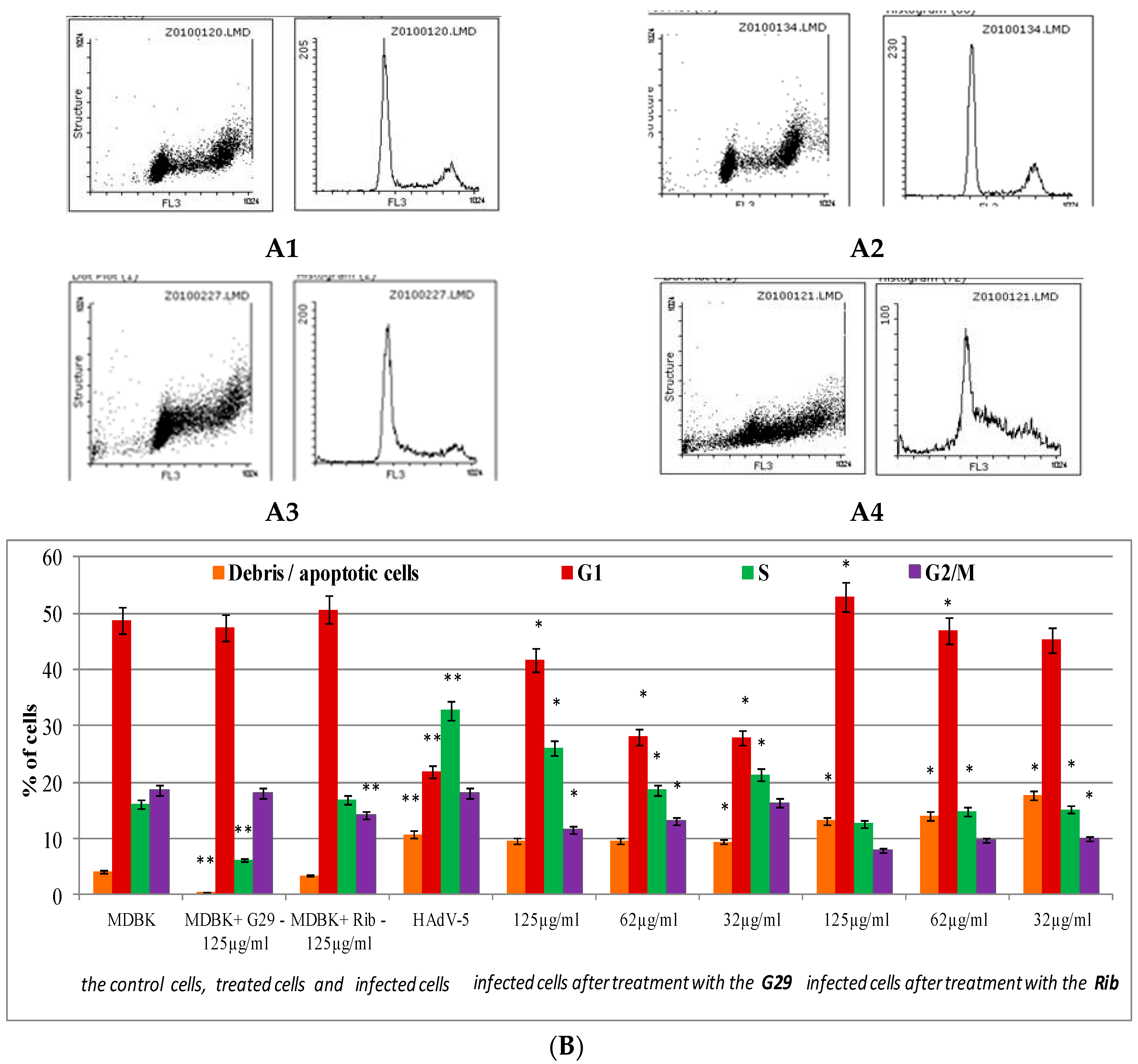Anti-Adenoviral Activity of 2-(3-Chlorotetrahydrofuran-2-yl)-4-Tosyl-5-(Perfluoropropyl)-1,2,3-Triazole
Abstract
:1. Introduction
2. Materials and Methods
2.1. Viruses and Cells
2.2. Tested Substances
2.3. Cellular Toxicity and Antiviral Assay
(OD cell control) − (OD virus control) × 100%,
2.4. Determination of the Infective Titer of Adenovirus Synthesized De Novo
2.5. Cell Cycle Research by Flow Cytometry
2.6. Statistical Analysis
3. Results
4. Discussion
5. Conclusions
Author Contributions
Funding
Conflicts of Interest
References
- Ghebremedhin, B. Human adenovirus: Viral pathogen with increasing importance. Eur. J. Microbiol. Immunol. 2014, 4, 26–33. [Google Scholar] [CrossRef] [PubMed] [Green Version]
- Waye, M.M.Y.; Sing, C.W. Anti-Viral Drugs for Human Adenoviruses. Pharmaceuticals 2010, 3, 3343–3354. [Google Scholar] [CrossRef]
- De Clercq, E.; Li, G. Approved Antiviral Drugs over the Past 50 Years. Clin. Microbiol. Rev. 2016, 29, 695–747. [Google Scholar] [CrossRef] [PubMed] [Green Version]
- Robinson, C.M.; Singh, G.; Lee, J.Y.; Dehghan, S.; Rajaiya, J.; Liu, E.B.; Yousuf, M.A.; Betensky, R.A.; Jones, M.S.; Dyer, D.W. Molecular evolution of human adenoviruses. Sci. Rep. 2013, 3, 1812–1817. [Google Scholar] [CrossRef] [PubMed] [Green Version]
- Gillis, E.P.; Eastman, K.J.; Hill, M.D.; Donnelly, D.J.; Meanwell, N.A. Applications of fluorine in medicinal chemistry. J. Med. Chem. 2015, 58, 8315–8359. [Google Scholar] [CrossRef] [PubMed]
- De Clercq, E. Curious (old and new) antiviral nucleoside analogues with intriguing therapeutic potential. Curr. Med. Chem. 2015, 22, 3866–3880. [Google Scholar] [CrossRef] [PubMed]
- Cavaliere, A.; Probst, K.C.; Westwell, A.D.; Slusarczyk, M. Fluorinated nucleoside as an important class of anticancer and antiviral agents. Future Med. Chem. 2017, 9, 1809–1833. [Google Scholar] [CrossRef] [PubMed]
- ATCC® ANIMAL CELL CULTURE GUIDE. Available online: http://www.uab.cat/doc/ATCCguide (accessed on 17 August 2014).
- Green, M.; Loewenstein, P.M. Human adenoviruses: Propagation, purification, quantification, and storage. Curr. Protoc. Microbiol. 2006, 1, 14C.1.1–14C.1.19. [Google Scholar] [CrossRef]
- Kanishchev, O.S.; Gudz, G.P.; Shermolovich, Y.G.; Nesterova, N.V.; Zagorodnya, S.D.; Golovan, A.V. Synthesis and Biological Activity of the Nucleoside Analogs Based on Polyfluoroalkyl-Substituted 1,2,3-Triazoles. Nucleosides Nucleotides Nucleic Acids 2011, 30, 768–783. [Google Scholar] [CrossRef] [PubMed]
- Filimonov, D.; Lagunin, A.; Gloriozova, T.; Rudik, A.; Druzhilovskii, D.; Pogodin, P. Prediction of the biological activity spectra of organic compounds using the pass online web resource. Chem. Heterocycl. Compd. 2014, 50, 444–457. [Google Scholar] [CrossRef]
- Mosmann, T. Rapid colorimetric assay for cellular growth and surviral: Application to proliferation and cytotoxicity assays. J. Immunol. Methods 1983, 65, 55–63. [Google Scholar] [CrossRef]
- Chattopadhyay, D.; Chawla, S.M.; Chatterjee, T.; Dey, R.; Bag, P.; Chakrabarty, S. Recent advancements for the evaluation of antiviral activities of natural products. New Biotechnol. 2009, 25, 347–368. [Google Scholar] [CrossRef] [PubMed]
- Wold, W.; Tollefson, A. Adenovirus Methods and Protocols, 2nd ed.; Humana Press Inc.: Totowa, NJ, USA, 2007; 245p, ISBN 978-1-59745-166-6. [Google Scholar]
- Kohn, L.K.; Foglio, M.A.; Rodrigues, R.A.; Sousa, I.M.; Martini, M.C.; Padilla, M.A.; Lima Neto, D.F.; Arns, C.W. In Vitro Antiviral Activities of Extracts of Plants of The Brazilian Cerrado against the Avian Metapneumovirus (aMPV). Braz. J. Poult. Sci. 2015, 17, 275–280. [Google Scholar] [CrossRef]
- London Research Institute. Propidium Iodide Cell Cycle Staining Protocol. Propidium Iodide Staining of DNA. Available online: http://www.biolegend.com/media_assets/support_protocol/PICell20Cycle20Staining20Protocol.pdf (accessed on 25 May 2014).
- Darzynkiewicz, Z.; Crissman, H.A.; Robinson, J.P. Methods in Cell Biology: Cytometry, 3rd ed.; Academic Press: San Diego, CA, USA, 2011; Volume 63, 682p, ISBN-10: 0123997151, ISBN-13: 978-0123997159. [Google Scholar]
- Westwell, A.D. Fluorinated Pharmaceuticals: Advances in Medicinal Chemistry; Future Science Ltd.: London, UK, 2015; 145p. [Google Scholar]
- Trapp-Fragnet, L.; Bencherit, D.; Chabanne-Vautherot, D.; Le Vern, Y.; Remy, S.; Boutet-Robinet, E.; Mirey, G.; Vautherot, J.F.; Denesvre, C. Cell Cycle Modulation by Marek’s Disease Virus: The Tegument Protein VP22 Triggers S-Phase Arrest and DNA Damage in Proliferating Cells. PLoS ONE 2016, 9, e100004. [Google Scholar] [CrossRef] [PubMed]
- Grand, R.J.; Ibrahim, A.P.; Taylor, A.M.; Milner, A.E.; Gregory, C.D.; Gallimore, P.H.; Turnell, A.S. Human Cells Arrest in S Phase in Response to Adenovirus 12 E1A. Virology 1998, 244, 330–342. [Google Scholar] [CrossRef] [PubMed] [Green Version]
- Sandhu, K.; Al-Rubeai, M. Monitoring of the Adenovirus Production Process by Flow Cytometry. Biotechnol. Prog. 2008, 24, 250–260. [Google Scholar] [CrossRef] [PubMed]
- Daly, M.B.; Roth, M.E.; Bonnac, L.; Maldonado, J.O.; Xie, J.; Clouser, C.L.; Patterson, S.T.; Kim, B.; Mansky, L.M. Dual anti-HIV mechanism of clofarabine. Retrovirology 2016, 13, 20. [Google Scholar] [CrossRef] [PubMed]
- Gentile, I.; Borgia, F.; Buonomo, A.R.; Castaldo, G.; Borgia, G. A novel promising therapeutic option against hepatitis C virus: An oral nucleotide NS5B polymerase inhibitor sofosbuvir. Curr. Med. Chem. 2013, 20, 3733–3742. [Google Scholar] [CrossRef] [PubMed]
- Volynets, G.P.; Golub, A.G.; Bdzhola, V.G.; Yarmoluk, S.M. The role of protein kinase CK2 in the regulation of oncogenesis, apoptosis and cellular stress response. Ukr. Bioorg. Acta 2007, 2, 25–32. [Google Scholar]
- Pines, J. Protein kinases and cell cycle control. Semin. Cell Biol. 1994, 5, 399–408. [Google Scholar] [CrossRef] [PubMed]
- Prykhod’ko, A.O.; Dubinina, G.G.; Golovach, S.M.; Yarmoluk, S.M. Inhibitors of protein kinase CK2. Ukr. Bioorg. Acta 2004, 1, 39–48. [Google Scholar]
- Zou, R.; Kawashima, E.; Freeman, G.A.; Koszalka, G.W.; Drach, J.C.; Townsend, L.B. Design, synthesis, and antiviral evaluation of 2deoxyDribosides of substituted benzimidazoles as potential agents for human cytomegalovirus infections. Nucleosides Nucleotides Nucleic Acids 2000, 19, 125–153. [Google Scholar] [CrossRef] [PubMed]




| Concentration of the Compound, μg/mL | Titer of HAdV-5, IFU/mL | Inhibition of HAdV-5 Reproduction, % | |
|---|---|---|---|
| G29 | 125 | 1.2 × 105 | 90.34 |
| 62 | 1.5 × 105 | 88.26 | |
| 32 | 2 × 105 | 84.43 | |
| Rib | 125 | 2 × 103 | 99.84 |
| 62 | 2.3 × 104 | 98.23 | |
| 32 | 4.8 × 104 | 96.30 | |
| Virus control | 1.3 × 106 | - | |
© 2018 by the authors. Licensee MDPI, Basel, Switzerland. This article is an open access article distributed under the terms and conditions of the Creative Commons Attribution (CC BY) license (http://creativecommons.org/licenses/by/4.0/).
Share and Cite
Biliavska, L.; Pankivska, Y.; Povnitsa, O.; Zagorodnya, S.; Gudz, G.; Shermolovich, Y. Anti-Adenoviral Activity of 2-(3-Chlorotetrahydrofuran-2-yl)-4-Tosyl-5-(Perfluoropropyl)-1,2,3-Triazole. Medicina 2018, 54, 81. https://0-doi-org.brum.beds.ac.uk/10.3390/medicina54050081
Biliavska L, Pankivska Y, Povnitsa O, Zagorodnya S, Gudz G, Shermolovich Y. Anti-Adenoviral Activity of 2-(3-Chlorotetrahydrofuran-2-yl)-4-Tosyl-5-(Perfluoropropyl)-1,2,3-Triazole. Medicina. 2018; 54(5):81. https://0-doi-org.brum.beds.ac.uk/10.3390/medicina54050081
Chicago/Turabian StyleBiliavska, Liubov, Yuliia Pankivska, Olga Povnitsa, Svitlana Zagorodnya, Ganna Gudz, and Yuriy Shermolovich. 2018. "Anti-Adenoviral Activity of 2-(3-Chlorotetrahydrofuran-2-yl)-4-Tosyl-5-(Perfluoropropyl)-1,2,3-Triazole" Medicina 54, no. 5: 81. https://0-doi-org.brum.beds.ac.uk/10.3390/medicina54050081





